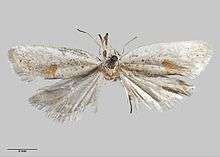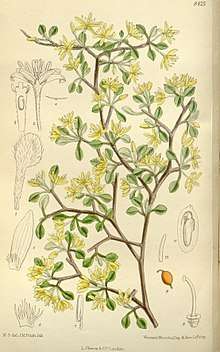Ericodesma cuneata
Ericodesma cuneata, the Corokia leafroller moth, is a species of moth in the family Tortricidae. It is endemic to New Zealand. This moth is classified as "At Risk, Naturally Uncommon" by the Department of Conservation.
| Ericodesma cuneata | |
|---|---|
 | |
| Holotype specimen | |
| Scientific classification | |
| Kingdom: | |
| Phylum: | |
| Class: | |
| Order: | |
| Family: | |
| Genus: | |
| Species: | E. cuneata |
| Binomial name | |
| Ericodesma cuneata (Clarke, 1926)[1] | |
| Synonyms[2] | |
| |
Taxonomy
This species was first described by Charles E. Clarke in 1926 using a specimen collected by him at Hope Arm, Lake Manapouri and named Tortrix cuneata.[2][3] In 1971 John S. Dugdale assigned Tortrix cuneata to the genus Ericodesma.[4] The holotype specimen is held at the Auckland War Memorial Museum.[2]
Description
Clarke described the species as follows:
♂. 13 mm. Head and thorax light grey; palpi moderate. Antennae grey, antennal ciliations 1⁄2. Abdomen pale ochreous-grey. Forewings elongate, costa moderately arched, apex bluntly pointed, termen slightly rounded, oblique; pale grey with a number of small obscure dots with tendency to form rows; a transverse blunt wedge-shaped red bar at 1⁄2 of dorsum, reaching half-way across wing. Hindwings pale ochreous-grey: cilia pale grey.[3]
Distribution
This species is endemic to New Zealand.[1][5] E. cuneata can be found at Taupo, Otago Lakes and Fiordland.[6] The species, although rare, can be found frequently at The Wilderness in Southland.[7]
Biology and behaviour
The larvae of this species web leaves together on the foliated stems of its host plant.[8]
Host species and habitat

The larvae of E. cuneata feed on Corokia cotoneaster, (korokio).[6] However the moth has not been associated with urban plantings of its host.[6] The adult moth has been collected in beech forest habitat,[3] as well as at strongly leached terraces and plains commonly called "wilderness".[7]
Conservation Status
This species has been classified as having the "At Risk, Naturally Uncommon" conservation status under the New Zealand Threat Classification System.[9]
References
| Wikimedia Commons has media related to Ericodesma cuneata. |
- Gordon, Dennis P., ed. (2010). New Zealand Inventory of Biodiversity. Volume two. Kingdom Animalia: Chaetognatha, Ecdysozoa, Ichnofossils. 2. Christchurch, N.Z.: Canterbury University Press. p. 464. ISBN 9781877257933. OCLC 973607714.
- Dugdale, J. S. (1988). "Lepidoptera - annotated catalogue, and keys to family-group taxa" (PDF). Fauna of New Zealand. 14: 117. Retrieved 20 May 2018.
- Clarke, Charles E. (1926). "New species of Lepidoptera". Transactions and Proceedings of the New Zealand Institute. 56: 417–421. Retrieved 21 May 2018.
- Dugdale, J. S. (10 November 1971). "Entomology of the Aucklands and other Islands south of New Zealand: Lepidoptera, excluding non-Crambine Pyralidae" (PDF). Pacific Insects Monograph. 27: 55–172 – via Bishop Museum.
- "Ericodesma cuneata (Clarke, 1926)". www.nzor.org.nz. Landcare Research New Zealand Ltd. Retrieved 2018-05-21.
- Patrick, B. H.; Dugdale, J. S. (2000). "Conservation status of the New Zealand Lepidoptera" (PDF). Science for Conservation. Department of Conservation, New Zealand. 136: 27. ISSN 1173-2946. Archived from the original (PDF) on 2017-05-01. Retrieved 2018-05-21.
- Dymond, John R., ed. (2013). "New Zealand's naturally uncommon ecosystems". Ecosystem services in New Zealand. Lincoln, N.Z.: Manaaki Whenua Press. p. 58. ISBN 9780478347364. OCLC 870683169.
- "PlantSynz - Invertebrate herbivore biodiversity assessment tool: Database". plant-synz.landcareresearch.co.nz. Landcare Research New Zealand Ltd. 2011. Retrieved 2018-05-21.
- Hoare, R.J.B.; Dugdale, J.S.; Edwards, E.D.; Gibbs, G.W.; Patrick, B.H.; Hitchmough, R.A.; Rolfe, J.R. (2017). "Conservation status of New Zealand butterflies and moths (Lepidoptera), 2015" (PDF). New Zealand Threat Classification Series. 20: 8.